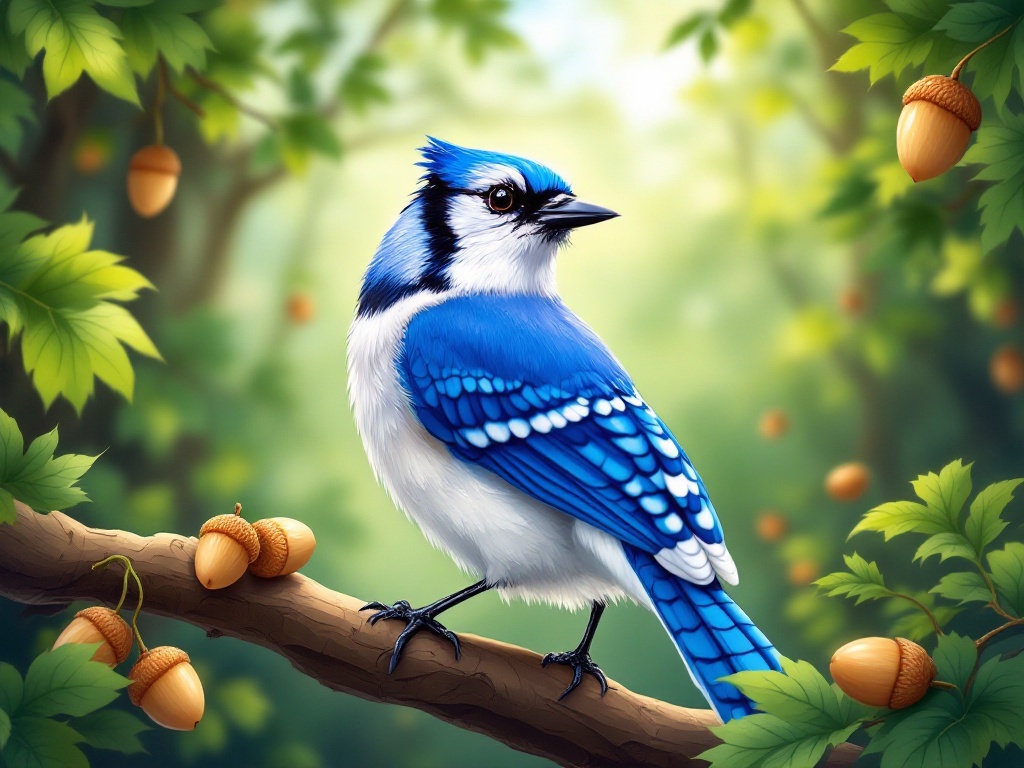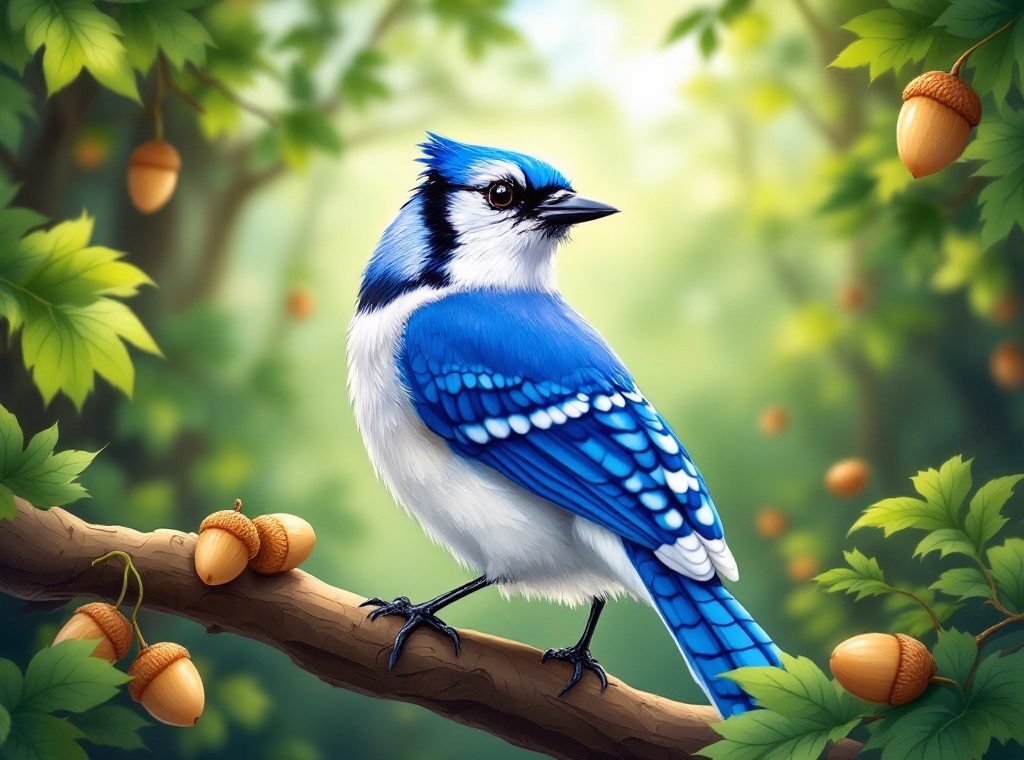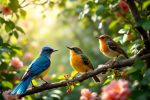Blue Jay Birds: Everything You Must Know About Them
Discover the captivating world of Blue Jays, the intelligent and vibrant songbirds renowned for their striking blue plumage and complex social lives. Learn how their brilliant color is a trick of the light, explore their remarkable mimicry skills, and understand their crucial role in forest regeneration. Uncover the secrets of their feeding habits, nesting behaviors, and the challenges they face in a changing climate. Explore practical tips for attracting these fascinating birds to your backyard and contributing to their conservation. Dive in and unlock the wonders of the Blue Jay!
Important information

- Blue Jays are intelligent, social birds known for their striking blue plumage, which is a result of light refraction, not pigment.
- They are skilled mimics, imitating hawks and other birds to deter predators or deceive other species.
- Blue Jays have a diverse diet, caching food like acorns and nuts, which contributes to forest regeneration.
- They are native to North America, with some populations migrating south for the winter.
- While their populations are declining due to habitat loss and predation, they can be attracted to backyards with feeders, fresh water, and oak trees.
Introduction to Blue Jay Birds
Blue Jays, vibrant members of the crow family, are medium-sized songbirds native to eastern and central North America. Known for their intelligence, these adaptable birds thrive in diverse habitats. Their striking blue plumage makes them easily identifiable, and their varied calls and songs contribute to their status as some of the region’s most noticeable and colorful birds.
Identification and Physical Characteristics
Instantly recognizable by their striking plumage, Blue Jays boast vibrant blue, white, and black feathers. A key identifying feature is the black U-shaped collar that graces their neck. Intricate black bars adorn their wings and tail, while a feathered crest on their head rises and falls with their mood. Interestingly, their brilliant blue hue isn’t due to pigment, but rather microscopic feather structures that refract light, creating a dazzling display of structural coloration.
Plumage and Structural Coloration
The brilliant blue, black, and white plumage of Blue Jays is instantly recognizable, but their signature color is actually an optical illusion. Instead of pigment, microscopic structures on their feathers scatter light, producing the vibrant blue hue. This shade shifts and changes depending on the viewing angle. These intricate feather patterns aren’t just for show; they play a crucial role in mate attraction and allow jays to identify one another.
Distinctive Features
Blue Jays are renowned for their striking blue plumage and boisterous calls. They are also skilled mimics, adept at imitating the cries of hawks and other birds. A lowered crest often indicates a peaceful feeding, a subtle cue within their complex social structure. These intelligent birds maintain strong family bonds.
Behavior and Intelligence
Blue Jays are social creatures, often living in close-knit family groups and congregating in large flocks. These intelligent birds are known for their problem-solving abilities, demonstrated by their resourceful use of tools like sticks and leaves to access hard-to-reach food. Their impressive mimicry skills allow them to imitate the calls of other birds, such as hawks, which they use to deter predators or deceive other species. Despite their intelligence and social nature, Blue Jays can also be aggressive, fiercely defending their nests, food sources, and territory.
Complex Social Systems and Family Bonds
Blue Jays are known for their strong family ties, often mating for life. These dedicated pairs collaborate on nest building and chick-rearing, further solidifying their bond.
Intelligence and Tool Use
Blue Jays are remarkably intelligent birds, demonstrating their resourcefulness by using tools like sticks to access hard-to-reach food and comfortably eating from bird feeders. Their diverse diet showcases their adaptability, encompassing seeds, nuts, insects, and fruit.
Territorial and Aggressive Behavior
Blue Jays fiercely defend their territory, aggressively repelling other birds, squirrels, and even small mammals from their food sources and nests. This behavior intensifies during breeding season and food shortages. This territoriality plays a vital role in maintaining their social order and securing access to crucial resources. This is supported by research.
Vocalizations and Mimicry
Blue Jays are renowned for their raucous calls, but they actually possess a surprisingly extensive vocabulary. These intelligent birds communicate using a combination of calls, songs, and body language. While some calls can be loud and harsh, like the familiar “jay!” sound, they also produce softer coos and whistles. Furthermore, Blue Jays are skilled mimics, able to imitate the sounds of other birds, such as hawks. This mimicry may serve to deter rivals or even test the alertness of other birds. Such complex vocalizations add another layer to their already intricate communication system.
Raucous Calls and Musical Sounds
Blue Jays are renowned for their noisy calls, using a variety of sounds to communicate. While their signature “jay, jay, jay” is well-known, they also produce clear whistles and other musical notes. These intelligent birds are skilled mimics, often imitating other species, particularly the Red-shouldered Hawk, sometimes to deceive their avian neighbors.
Mimicking Hawks and Other Sounds
Blue Jays are renowned for their vocal mimicry, expertly imitating predators like the sharp-shinned hawk to deter food competitors. Their repertoire extends to other birds, including owls and crows, facilitating interspecies communication and bolstering territorial defense. From whistles and clicks to chatters, their diverse calls play a crucial role in their intricate social lives. This complex vocal communication system helps Blue Jays establish territories, warn of danger, and maintain social cohesion within their flocks.
Diet and Feeding Habits
Blue Jays are omnivorous birds known for their diverse diet. They enjoy a variety of foods, including acorns, nuts, seeds, berries, and fruits. Their menu also features insects, eggs, and occasionally small vertebrates. Often foraging on the ground for fallen acorns and other treats, they also frequent bird feeders. At feeders, sunflower seeds, peanuts, and suet are among their favorites. These intelligent birds cleverly cache food, hiding it for later consumption. This behavior inadvertently helps spread seeds and contributes to forest regeneration.
Omnivorous Diet
Blue Jays are omnivorous birds known for their diverse diet. They consume a variety of foods, including nuts, seeds, acorns, insects, fruits, and occasionally small vertebrates. Acorns are a particular favorite. These intelligent birds often cache food, storing nuts and seeds for later consumption, which helps them survive winter’s scarcity. This caching behavior also contributes to the spread of oak trees.
Feeding Behavior and Ground Foraging
Blue Jays are omnivorous birds that forage for food in trees and on the ground. Among the leaves, they snatch insects, while nuts, seeds, and fruits also comprise their diet. These vibrant birds are common guests at bird feeders, where they relish suet and seeds.
Food Caching and Use of Feeders
Blue Jays cleverly store food for winter by burying nuts and seeds in the ground or tree crevices. This hidden stash becomes vital when food is scarce. However, these resourceful birds also readily take advantage of bird feeders, especially tray or hopper styles that offer easy access to nuts and seeds. These feeders provide a consistent food source during lean periods.
Habitat and Migration
Blue Jays flourish in various environments, especially deciduous and mixed forests abundant with oak trees. These brightly colored birds are frequently seen across eastern and central North America. Although some Blue Jays migrate, not all participate in these seasonal movements. Some stay in their habitats throughout the year, while others, mainly from northern areas, fly south for the winter. Eastern populations demonstrate a blend of both migratory and resident birds, traveling in informal groups with unpredictable migration routes.
Preferred Habitats and Range
Blue Jays flourish in a variety of habitats, from forests and woodlands to parks and residential areas across eastern and central North America. These adaptable birds thrive particularly well in urban environments, especially those with oak trees, as acorns are a staple in their diet.
Migration Patterns and Range Maps
Blue Jays are social birds, traveling in flocks of 5 to 250 individuals. While some migrate, others remain in a single location year-round, earning them the title “resident.” Their distribution across North America, including breeding and wintering grounds, is illustrated by range maps.
Wintering Behavior in Eastern North America
Eastern Blue Jays display a unique migratory behavior. Some jays brave the winter, while others migrate south for warmer temperatures.
The jays that stay put exhibit impressive resourcefulness, using resources such as bird baths to obtain essential water during winter. This cleverness enables them to survive harsh winter conditions.
Nesting and Breeding
Blue Jays build their nests in trees, typically between 3 and 10 meters high.
Both male and female Blue Jays gather materials like twigs, leaves, bark strips, moss, and sometimes mud to construct their nests.
They prefer to nest in dense foliage of conifero

















